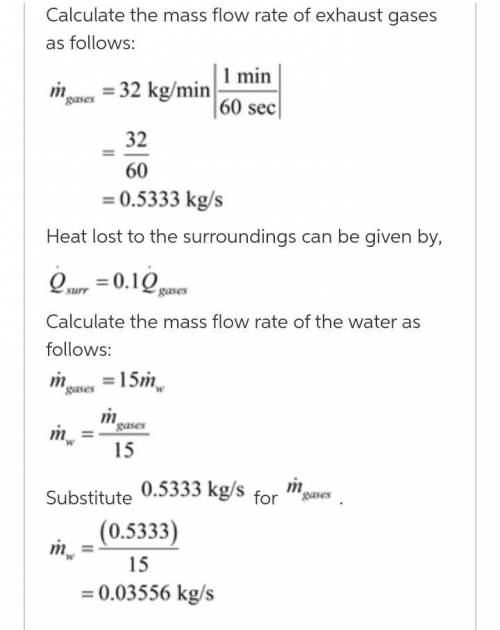
Engineering, 11.03.2020 05:09 stormhorn491
Hot exhaust gases of an internal combustion engine are to be used to produce saturated water vapor at 2 MPa pressure. The exhaust gases enter the heat exchanger at 400oC at a rate of 32 kg/min while water enters at 15oC. The heat exchanger is not well insulated, and it is estimated that 10% of heat given by the exhaust gases is lost to the surroundings. The mass flow rate of the exhaust gases is 15 times that of the water and constant specific heat properties of the exhaust gases can be approximated using the properties of air at 600K. Determine the temperature of the exhaust gases leaving the heat exchanger and the rate of heat transfer to the water.

Answers: 1


Another question on Engineering

Engineering, 04.07.2019 18:10
Steel is coated with a thin layer of ceramic to protect against corrosion. what do you expect to happen to the coating when the temperature of the steel is increased significantly? explain.
Answers: 1

Engineering, 04.07.2019 18:20
A3-mm-thick panel of aluminum alloy (k 177 w/m-k, c 875 j/kg-k and ? = 2770 kg/m) is finished on both sides with an epoxy coating that must be cured at or above t,-150°c for at least 5 min. the production line for the curing operation involves two steps: (1) heating in a large oven with air at ts,0-175°c and a convection coefficient of h, 40 w/m2. k, and (2) cooling in a large chamber with air at 25°c and a con- vection coefficient of he 10 w/m2.k. the heating portion of the process is conducted over a time interval te which exceeds the ime required to reach 150°c by 5 min (h = r + 300 s). the coating has an emissivity of ? = 0.8, and the temperatures of the oven and chamber walls are 175 and 25°c, respectively. if the panel is placed in the oven at an initial temperature of 25°c and removed from the chamber at a safe-to-touch tempera ture of 37°c, what is the total elapsed time for the two-step curing operation?
Answers: 3

Engineering, 04.07.2019 19:20
At steady state, air at 200 kpa, 325 k, and mass flow rate of 0.5 kg/s enters an insulated duct having differing inlet and exit cross-sectional areas. the inlet cross-sectional area is 6 cm2. at the duct exit, the pressure of the air is 100 kpa and the velocity is 250 m/s. neglecting potential energy effects and modeling air as an 1.008 kj/kg k, determine ideal gas with constant cp = (a) the velocity of the air at the inlet, in m/s. (b) the temperature of the air at the exit, in k. (c) the exit cross-sectional area, in cm2
Answers: 2

Engineering, 06.07.2019 02:30
On solidification from a melt, the polymer polyethylene forms a semi-crystalline spherulite structure. (i) sketch an individual spherulite and label the amorphous and crystalline regions. (ii) draw a schematic to show the changes in specific volume with temperature during cooling from the melt, comparing it to the theoretical extremes of fully crystalline and fully amorphous (indicate tm and tg)
Answers: 2
You know the right answer?
Hot exhaust gases of an internal combustion engine are to be used to produce saturated water vapor a...
Questions

Mathematics, 07.05.2021 01:00

Advanced Placement (AP), 07.05.2021 01:00



History, 07.05.2021 01:00

Mathematics, 07.05.2021 01:00

Mathematics, 07.05.2021 01:00

History, 07.05.2021 01:00

Mathematics, 07.05.2021 01:00

Mathematics, 07.05.2021 01:00

English, 07.05.2021 01:00



English, 07.05.2021 01:00










